
|
Home DH-Debate 38. Abel 40. Erik Klipping |
In the summer of 1252, King Abel fell on Husum Bridge in battle against the Frisians.
A few weeks later, his younger brother, Christoffer 1. was elected his successor.
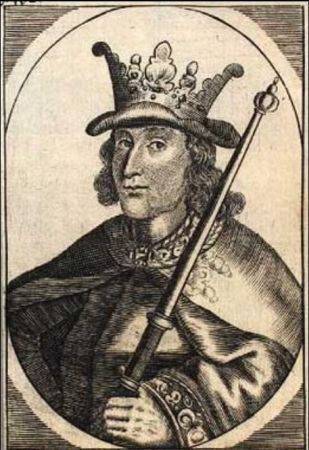
Christoffer 1. Born 1219 - died 1259. He ruled Denmark 1252 - 59. There is with great certainty no portrait likeness. Copper engraving from the period approx. 1500-1795. Det Kongelige Bibliotek.
Abel's eldest son, Valdemar Abelsen, had been kidnapped by the Archbishop of Cologne on his way home from a study stay in Paris and was in captivity in Cologne, and therefore he could not run for royal office as his father's successor.
Several historians describe Christoffer's election as a kind of coup, an unfair deviation from the old custom that a deceased king should be succeeded by his eldest son. They argue that the electoral kingdom was an empty formality.
But just over a hundred years before, Sweyn Estridson's sons had succeeded each other as brothers, despite the fact that several of them had sons.
After Erik Lam's death in 1147, the Jutlanders initially refused to approve Erik Emune's son, Svend Grathe, probably because they did not want a son of a brother murderer as king, as Erik Emune had murdered his brother, Harald Kesja, and eleven of his twelve sons - of which many minors.
In addition, Erik Lam himself had a son named Magnus, who did not at all come up as a royal candidate at his death in 1147.
Both Valdemar the Victorious and Abel himself succeeded their brothers as kings.
Therefore, it is very possible that the electoral kingdom was real and that the Danes preferred Christoffer 1. to Valdemar Abelsen because they did not want a son of a brother-murderer as king.
Christoffer I inherited a kingdom that was atacked on three fronts.
The most serious challenge was the Abel lineage in Slesvig, who wanted to make Denmark smaller by in practice making their duchy an independent principality of the kind that there were already many of in Germany at the time, however, in suche a way that they were open to the Abel lineage to take over the Danish throne.

|
Royal dynasties through the history of Denmark. However, all the kings - except Magnus the Good - come from "Hardegon, son of a certain Sven" , who conquered a large part of Jutland around 917 as narrated by Adam of Bremen in the section about Hoger. The kings and tales of war and peace are the backbone of history - not that stories about culture and the living conditions of ordinary people are not important and interesting - but without the royal line, the history can easily degenerate into a kind of unstructured fireplace conversation, which not easily and immediately can be organized and timed in the mind. It gives a good overview to divide the royal line - and thus Danish history - into manageable sections.
The Knytlinge lineage gets its name from Hardecnudth, probably son of Hardegon. He is also called Knud 1. and was with reasonable likelyhood the father of Gorm the Old as told by Adam of Bremen in the section of Unni. Magnus the Good, who became king in 1047, was the son of the Norwegian saint king, Olav; his reign constitutes a transitional period to the time of Sweyn Estridson and his sons and grandsons.
The rival kings, Svend, Knud and Valdemar, from 1146 to 1157, all descended from Sweyn Estridson; their time constitutes an interregnum to the time of the Valdemars.
Many historians, probably most, include only Valdemar the Great, his son Canute the Sixth and Valdemar the Victorious to the Valdemars. But one can not have a patent on such a definition, and it seems appropriate for the author to include their less successful descendants - including Erik Plovpenning, Abel and Christoffer 1. - until Christoffer 2. who was the last king before Denmark's kingless time from 1340.
Valdemar Atterdag was not king of the Kalmar Union, but his grandson, Olaf was, and his daughter Margrete 1. became the reigning queen of the Scandinavian Kalmar Union. One can say - with a little good will - that Valdemar Atterdag restored Denmark and thus the possibility of the Kalmar Union with Norway and Sweden.
The first Oldenburg kings were also Union kings but only for short periods.
The Civil War, The Count's Feud, 1534-36 was a decisive turning point in Denmark's history. As a consequence of the Lutheran Reformation, which took place at the same time, the kings confiscated the third part of Denmark's agricultural land that belonged to the church. This fantastic wealth made it possible for them to subdue Denmark's old nobility and after some time to establish the autocracy, which became an important cause for Denmark's historic deroute. In 1848, a democratic constitution was introduced without civil war or other violent events.
The Oldenburg royal line died out in 1863 with the childless Frederik 7. The throne was then given to Christian 9. of Glücksborg.
Led by Archbishop Jacob Erlandsen, parts of the church fought fiercely for greater independence from the monarchy, as was common at the time in the rest of Europe. Yes, in fact, they worked for the church to have superiority over the monarks.
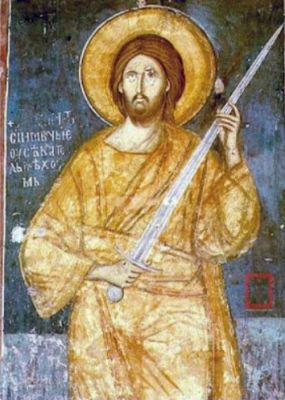
Fresco from the 1300's in the monastery Visoki Decani in Kosovo, which shows Jesus with a sword. An alternative interpretation of Luke 22:37 is that Jesus would let the disciples understand that in this situation they could not do anything against the Roman soldiers, they would just "perish by the sword" . Jesus was not fundamentally opposed to carrying or using weapons. Photo Orthodox Christianity Then and Now.
During his many years at the papacy, we must believe that Erlandsen had acquired the idea of the two swords based on Jesus' words on his way to the Garden of Gethsemane in the Gospel of Luke 22:37 "For I say unto you, that this that is written must yet be accomplished in me", And he was reckoned among the transgressors: for the things concerning me have an end. And they said, "Lord, behold, here are two swords". And he said unto them, "It is enough."
Already in the early Middle Ages, Pope Gelasius interpreted the scripture so that the two swords symbolize the spiritual and the secular power, respectively. However, in such way that the spiritual authority, the church, has both swords at its disposal - but has handed over one to the secular power. The Church is responsible to God also for the exercise of worldly authority, and therefore the spiritual power is superior to the worldly power.
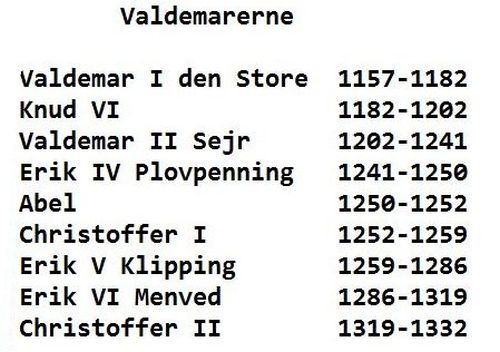
The Valdemars. It is common to count only Valdemar the Great, Canute the Sixth. and Valdemar the Victorious to the Valdemars. But in this way their less successful descendants become pedagogically homeless, even though they are really direct descendants after the first and more famous Valdemars, and they are not separated from these by any natural period of transformation. Therefore, I would suggest that the whole group until the kingless time to be called the Valdemars.
Erik Ploughpenning, Abel and Christoffer were sons of Valdemar Sejr and succeeded each other as kings. Abel most likely killed his brother, Erik, and immersed his body in the fjord Slien. But, 24 knights swore that Abel was innocent, and therefore he was elected king anyway. However, he was soon killed in battle during a campaign in Friesland, and then his younger brother Christoffer was chosen as his successor, and the eldest son of the deceased Abel was thereby bypassed. This led in the following decades to a long-standing rivalry between the descendants of Abel and Christoffer, respectively, and contributed to the contradiction that developed over the course of history between Denmark itself and the duchies.
Christoffer's son, Erik, who was later bynamed Klipping, became king only 10 years old with his dynamic mother, Margrete Sambiria, as guardian. The cieftains limited his power with a contract at Nyborg Castle, which among other things said that the meeting of king and great men, which was later called Danehof, should be the country's highest court. Furthermore, it was held that the Court could only deal with cases which had not previously been treated by another court and that it could only impose pre-standardized fines. Erik Klipping was killed in Finnerup Lade near Viborg with 56 stab wounds - it is still one of the great mysteries in Danish history. His son Erik Menved sought to create goodwill and increased influence in northern Germany by holding some magnificent - but expensive - knight tournaments. He was succeeded by his brother, Christoffer 2. who had to take over his brother's large debts, while at the same time the possibilities of increasing the royal revenue by increased taxes were blocked by a contract. When he died in 1332, no new Danish king was elected, and the country was without a king for a period.
However, there are no historical sources that support that Jacob Erlandsen should have worked for an actual theocracy - that is, a form of government where the whole nation is led by a religious head - such as the Vatican and ancient Tibet.
But the Archbishop was of the rich and powerful Hvide lineage, who had turned in irreconcilable enmity against Erik Ploughpenning and the Danish monarchy. They had actively participated in the assassination of the king and continued to support the Abel lineage in Slesvig.
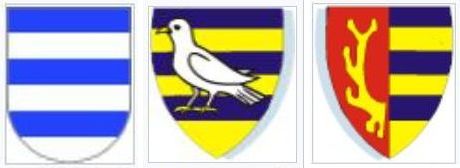
Examples of the coat of arms of the Hvides. Three horizontal beams were characteristic of a Hvide Knight's coat of arms.
From left to right: Sune Ebbesen's - who was a Hvide - coat of arms with the characteristic horizontal beams, a characteristic Hvide coat of arms with beams and a dove and one with beams and antlers. Photo zoizit Wikipedia.
Although Christoffer had been an ally of the Abel and the Hvide lineages in the revolt against King Erik, they nevertheless transferred their enmity against the royal power to him as well and remained the irreconcilable enemies of the Danish king. It became especially clear when Jacob Erlandsen refused to crown Christoffer's young son, Erik - who would later be bynamed Klipping - as a co-king, as had been the custom among the Valdemars since Valdemar the Great.
The Hvide lineage's enmity towards the Danish kings is a mystery. They had loyally supported Valdemar the Great, Canute the Sixth and probably also Valdemar the Victorious, but they turned quite suddenly in enmity against Erik Ploughpenning and Christoffer 1.
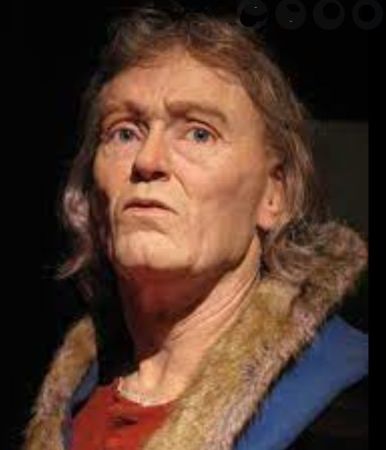
Birger Jarl as he has been recreated from his skull at Medeltidsmuseet in Stockholm. Photo Facebook.
One can guess a motif by taking a look at Sweden just at this time. Here the kingdom's most powerful man, Birger Jarl, had pushed the traditional royal families aside and had his own son elected king.
A similar series of events can be recognized in the early history of the Franks, where the house master, Karl Martel, pushed aside the historical royal family - the long-haired Merovingians - and made his own son king.
Perhaps the Hvide lineage had formed themselves such an idea that it was fair and appropriate that the king should be chosen from the country's richest and most powerful family - which was the Hvides.
In addition to the Abel family, the Hvide family and parts of the church's uncompromising hostility, Christoffer had also inherited Sweden and Norway's enmity towards Denmark, which was originally created by Abel's involvement in a Swedish civil war.
Christoffer 1. was the third son of Valdemar the Victorious, who became king of Denmark. The historian Erik Kjersgaard says that a contemporary yearbook writes "that he was like his father. He was brave, gifted, and a good christian; but he would seldom open his clenched hand and stretch it forward to a handshake."
Christoffer's mother Berengaria died as early as 1221, when he was two years old.
Together with Abel, he replaced their half-brother, Valdemar the Young, in 1226, as a hostage at Henry of Schwerin. Abel was at this time 8-9 years old and Christoffer 7 years.
It is unclear how long they stayed in Schwerin. They may have been released when Count Henry of Schwerin died in 1228, when Valdemar the Victorious paid the last installment of the ransom in 1230 or one of the brothers had to stay in Schwerin until 1235 as a guarantee against a war of revenge.
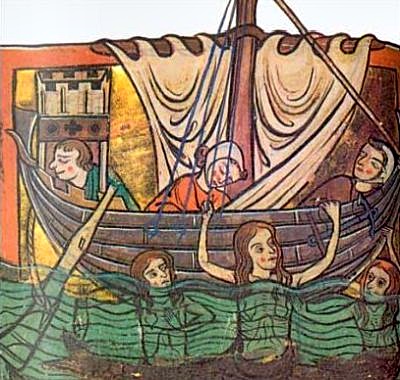
Ship from around 1250, which is kept afloat by mermaids while the crew sleeps. The ship is carvel-built, carries a single mainsail and has a steering oar and castle at the stern. Photo Bodlion Library Oxford.
One should not imagine that they were sitting in a cell for water and bread. They have probably had a relatively normal life for boys their age at the castle in Schwerin - in exchange for them and their companions swearing they would not flee.
When Christoffer's eldest brother, Erik, was crowned as his father's co-king in 1232, Abel was at the same time appointed "Duke of Jutland" - by which is meant Slesvig - and Christoffer became lord or duke of the islands of Lolland and Falster. Possibly one of these appointments has been in absentia.
During the civil war between Erik Ploughpenning and Abel, Christoffer joined Abel's party. But he was captured by Erik. The Næstved Yearbook under 1248 tells that Erik made a raid to Arreskov on Fyn, which belonged to Abel as his ancestral inheritance. Here "he occupied the castles and estates of all his brothers" . Both Christoffer and his half-brother Duke Knud of Blekinge were captured.
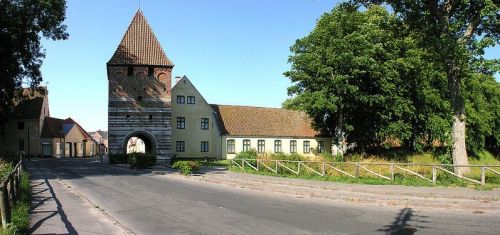
Mølleporten in Stege, which is the only part left of Stegeborg on island of Møn. the A.P. Møller Foundation has just donated funds for a thorough restoration. Photo Fortidsmindeguide.
However, at this time the Lübeckers ravaged Denmark, as in former time the Slaws - among other things, they burned Copenhagen. Later in the year 1248 they attacked the castle Stegeborg on the island of Møn and liberated Knud of Blekinge and probably on this occasion also Christoffer.
In any case - also in 1248 - Christoffer - now 29 years old - was free and able to marry the later so famous Margrete Sambiria, who was the daughter of Duke Sambor 2. of Pomerellen, who was a modest duchy in the part of eastern Pomerania which now belongs to Poland.
The power of the king had been weakened during the time of the Valdemars due to the two social dissolution processes of the Middle Ages. Namely, the ever-increasing power of the church due to the constant flow of gifts to the church in the form of land and rights from kings and nobles for the salvation of their souls, and the regularly recurring endowments of princely lens to royal princes who had no prospect of inheriting the throne. In addition, there were recurring demands from existing princes that their county should be hereditary and even more independent of the king.
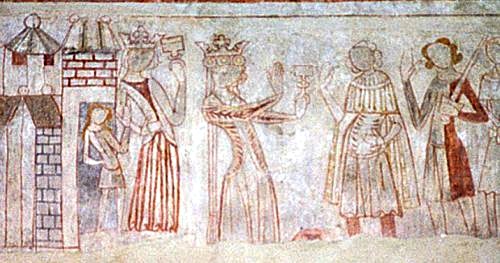
The guests are welcomed, you could call this fresco from Ørslev Church by Skælskør - about 1350. Photo Øresundstid.
The historian Erik Kjersgaard writes that from ancient times it had been customary for the king to convene his sworn men once a year for a meeting, a kind of army gathering - a show of the existing armed forces. It sounds very likely that the nobles should occasionally show that they were ready for war when the king called - in return for their tax exemptions.
Thanks to this weakening of the monarchy in the generation after Valdemar the Victorious, the aristocracy, the best men in the kingdom, was able to force this army gathering developing into a "hof" - that is court - which became an organ for nobility and clergy in the country's government. In later times this assembly was to be called Danehof.
The old laws - Jutland Law, Sjælland Law, Scanian Law and Frisian Law - did not provide rules for a king's entire are of activity. There was a great deal of leeway for the king's prerogative, that is, the possibility of royal decisions, which were not regulated by laws.
Now, however, the great men demanded that this leeway to be reduced by the king being obliged to follow certain rules laid down in a contract between the king and the great men present at the "hof" - in the form of a "handbinding" - that is restrictions of the hands of the king - which to some extent can be compared with a constitution.
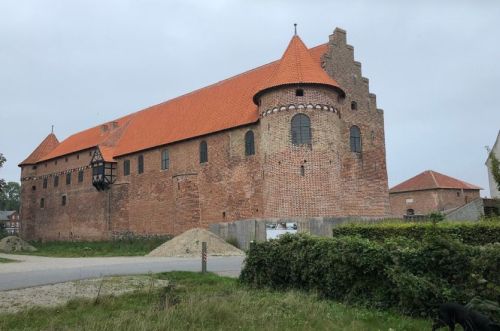
Danehof was held at Nyborg Castle from Christoffer 1's time around 1255. Heirs to the throne were elected, "handbindings" adopted, royal assassins and traitors convicted. The very hall in which the meetings were held can still be displayed. But in one of Jacob Erlandsen's complaints about Christoffer, he complains that this king had changed the meetings by moving them from his "chamber" out into the open. Which indicates that already in Christoffer's time the meetings were a recurring event. The last Danehof was held in 1413, when King Erik of Pomerania wanted to legitimize his claim to the Duchy of Slesvig. Photo TheTopTours.
In the time since Valdemar the Great, kings had coined the term "crime against the majesty." The definition of this crime was not only attack on the king's person, but also defiance and disobedience to his direct commands. For example, if the king had taken a monastery in his defense, it would be a "crime against the majesty" to violate its rights.
Lokale adelsmænd, som for eksempel krænkede sådan et kongens værn, kunne blive hjemfaldne til kongens "nåde og unåde". Det vil sige at de kunne blive udsat for kongens vilkårlige straf - for eksempel konfiskation af deres ejendom eller lignende.
But now the assembly of nobles and bishops demanded that a fixed procedure should be established for the trial of "crimes against the majesty". When there was an indictment, the king was to summon the accused in three consecutive letters. If he did not show up he would have judged himself. A tribunal was to be set up appointed by two respected men from the accused's home region.
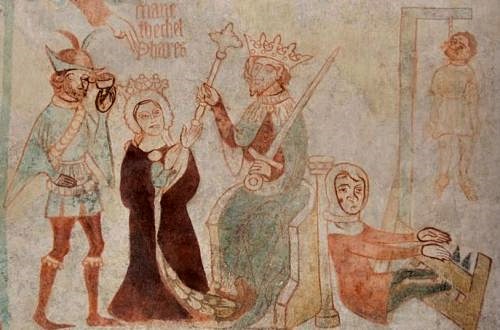
Fresco from approx. 1250, which depicts Esther's intercession for the Jew Mordecai from the Book of Esther in the Old Testament - in the background convicted criminals. Tirsted Church north of Rødby on Lolland. Photo Peter Lehrman.
The assembly demanded that the king should be allowed to adjudicate only in cases which had already been dealt with by another court. The king only had to impose standardized fines and penalties.
When Christoffer agreed to let his power be limited by such rules, the same naturally applied to his bailiffs as well. They had to swear by the Bible that they would be righteous in all matters, they had to refrain from inventing new charges and refraining from accepting bribes.
Abel fell on Husum Bridge in the summer of 1252 and a few weeks later Christoffer was elected king of Denmark. Among the Abel-family in Slesvig and Holsten, the election of Christoffer 1. was perceived as a regular usurpation of the throne.
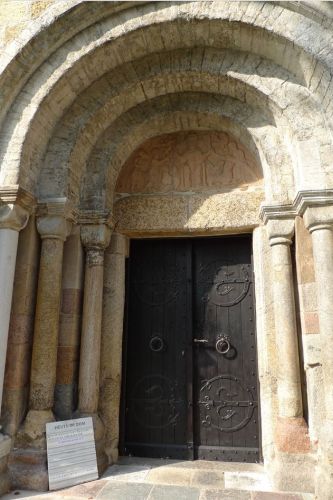
Peter's portal from around 1180 in Slesvig Cathedral. It was the time of Valdemar the Great and Canute the Sixth. At that time, the whole of Slesvig was Danish. It was in Slesvig that Valdemar the Young was crowned as Valdemar the Victorious's co-king the day of saint Johannes 1218. Photo Strand und Steine.
Some historians say that the widowed queen Mechtilde and her sons, Erik and Abel, redeemed Valdemar Abelsen for funds that they borrowed from her brothers, the Holsten counts, against a mortgage in the area between the fjord Slien and the river Ejder and the fortress of Rendsborg. It was in this way that this area was originally connected to Holsten and Germany.
As early as September 1252, a Holsten army moved into the rest of the duchy and conquered the city of Slesvig, which was looted. The priests of the cathedral could then tell about the miracles with which God had shown his disgust for the brutal conduct of the Holstenians. The images of the saints shed tears, and a Holsten soldier, who grinningly declared that the miracles were simply due to some women pouring water over the figures, went insane as punishment for his blasphemy and tore himself to death with his nails.
It is said that at about the same time the Norwegians broke into North Halland and ravaged and plundered.
The newly crowned king, Christoffer, resolved the crisis by diplomatic means. He satisfied the Norwegians by promising the Norwegian merchants compensation for the losses they had suffered during the civil war - which promise Abel had already given them, but apparently did not keep. Christoffer pledged North Halland to King Håkon of Norway as a guarantee that he would keep his promise.
He satisfied the Holsteins by promising to make the young Valdemar Abelsen Duke of Slesvig, as his father had been. However, Christoffer did not succeed in recapturing the city of Slesvig until 1254.
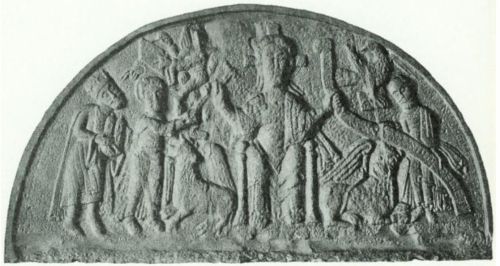
The semicircular so-called tympanum over the door of St. Peter's Portal in Slesvig Cathedral from around 1180. The relief has given its name to the portal as it depicts the handing over of the key to St. Peter as it is written in the Gospel of Matthew: "And I will give unto thee the keys of the heavens, and whatsoever thou shalt bind on earth shall be bound in the heavens, and whatsoever thou shalt loose on earth shall be loosed in the heavens."
In the middle of the picture is the enthroned Christ with the cross halo, surrounded by the four evangelist symbols. On his left is the apostle Paul, who is given a
text tape. Unfortunately, part of the band's Latin inscription has disappeared due to the weathering of the stone. The first part of it, however, is uniquely reconstructed and translated thus: "Drive me out the mad tyrant of this world and call back those people." Thus a command to Paul to drive out the pagan earthly ruler and lead the people back to the Christian church. On the right side of Christ is the apostle Peter, who is given the keys. Far to the left stands a princely person with a crown on his head; in his hands he holds a model of a church with two towers. Above the figure is seen the hand of God outstretched for blessing. Photo Grænseforeningen.
But that kind of crisis solution should create even bigger problems in the future. He had allowed Denmark's enemies to gain a foothold inside the border areas.
In 1257, the Duke of Slesvig, Valdemar Abelsen, died quite young - not much more than 20 years old. Ryd Monastery Chronicle writes for the year 1257: "In addition, Valdemar - King Abel's son died". He had no heirs, and therefore the Duchy of Slesvig was formally reverted to the Danish crown.
This did not happen immediately, because in 1258 the Holstenians again attacked Slesvig and Denmark, probably inspired by calls from the archbishop Jacob Erlandsen to strike down the enemies of Christianity - supported by another of Denmark's irreconcilable enemies, namely Abel's widow, Mechtilde of Holsten, the Holsten counts' sister.
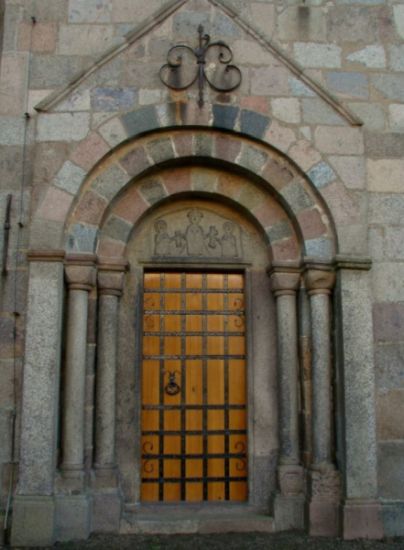
Romanesque portal in Sørup Church. In South Slesvig there are several portals which have clear similarities with the Saint Peter portal in Slesvig. These are the Marie Kirke in Sørup and the churches in Munkbrarup and Nørre Brarup. They are, or have been, equipped with distinguished pillar portals, the tympanums of which show Christ between the apostles Peter and Paul. They are probably all built around 1180, which is the period of Valdemar the Great and Canute the Sixth. At that time, the whole of Slesvig was indisputably Danish. Photo Strand und Steine.
But Christoffer defeated the Holstenias and took possession of the city of Slesvig again, and here in 1258 he had his brother, Erik Ploughpennings' body taken up from Slesvig Cathedral and taken to Ringsted. Ryd Monastery Krønike writes for the year 1258: "Christoffer - King Erik's brother - had the aforementioned King Erik excavated from Saint Peder's Church and taken away, while Bishop Niels was not present"
King Christoffer was an intelligent and energetic man. He had made the plan to make his brother a saint because of his tragic death at the hands of evil men. It would benefit the royal family and not least discredit the Abel family, who were responsible for his death, and thus strengthen the royal family in the fight to win back Slesvig as a natural part of the Danish kingdom.
The men of the Church were divided into two parties. One wing was led by Archbishop Jacob Erlandsen and Bishop Peder Skjalmsen of Roskilde, who with great consequence worked to end all worldly influence on the church, the church should only be governed by its own men and its own laws, namely the international church law.
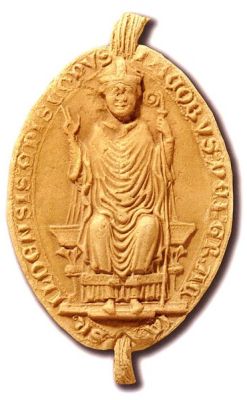
Jacob Erlandsen's seal. Photo Sven Rosborn Wikimedia Commons
Jacob Erlandsen was elected archbishop by the monks of the cathedral in Lund as early as 1252, but due to opposition from King Christoffer, he could only take over the office in 1254 after a settlement that required him to take the oath of allegiance to the king.
The other ecclesiastical wing, which was the majority, insisted that the bishops should be loyal to the king of the land. Their leader was Bishop Niels, who in 1251 had succeeded the venerable Bishop Gunner - the author of Jutland Law's preface - on the Viborg's bishopric.
Archbishop Erlandsen had an aggressive interpretation of the church's teaching on the two swords: "Just as there are two swords, one secular and one spiritual, so there are also two princes, judges and courts. The king must know that just as the spiritual has precedence over the worldly, so also the right of the church has precedence over the worldly right; if there is disagreement between them, the less must give way to the greater, the temporal to the spiritual."
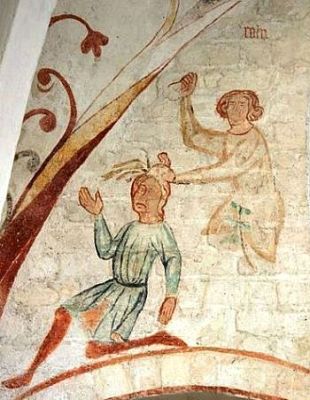
Fresco of Cain's murder of Abel in Vester Broby Church near Sorø. Foto Hans A. Rosbach.
As soon as he took office as archbishop, he insisted on bringing church law in line with the corresponding law further down in Europe, a reform that would increase the church's power in Denmark. But the peasants resisted being deprived of established rights and they were supported by the king, who also had established rights in relation to the church's property and servants, which Erlandsen's reform would dispose of.
In March 1256, Christoffer held Danehof in Nyborg. There was a large turnout, but the country's bishops did not show up to the appointed time. Jacob Erlandsen had namely summoned them to a meeting in Vejle on exactly the same day to discuss the security of the clergy, as Erlandsen's large-scale reform plan had triggered physical threats against some bishops.
In Vejle, the assembled clergy decided the declaration: "Cum Ecclesia Daciana" som lød: "Since the Danish church is under such severe persecution of perpetrators that one does not shy away from condemning in the king's own presence bishops, who stand as a solid wall around the house of God, the authority of the holy assembly has decreed that if any bishop within the borders of the Danish kingdom are captured, maimed or suffer other violent harm at the king's order or with his applause, or at the command of any nobleman, so that there is reason to believe that it has happened with the king's will, then all service of the church in the kingdom shall cease."
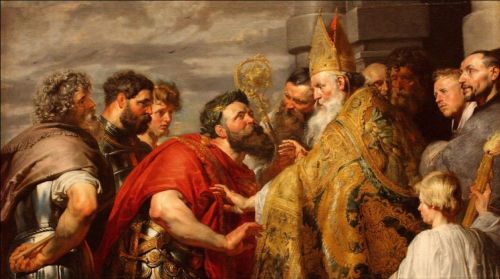
Classical European painting illustrating a bishop enforcing interdict. Foto Hypotheses.
After many days of delay, Jakob Erlandsen and the bishops finally arrived in Nyborg. Christoffer greeted them with a quote from Virgil: "Tardi venere bubulci" which means "The ox drivers arrive late" idet kongens ord ironiserer over gejstelighedens opfattelse af sig selv som hyrder for deres menigheder - idet pastor betyder hyrde. The "ox drivers" refer to - for example - the men who drove flocks of oxen along the Jutland army road to be sold in larger cities to the south.
The punishment that Jakob Erlandsen had intended for the king and his people, if they did not comply, was what is called "interdict", which means that all ecclesiastical service ceased and therefore no one gets forgiveness of their sins and the road to the Kingdom of Heaven was therefore blocked for the congregations.
The king and the archbishop disagreed on a number of things. The king wanted to have the right to take the bishops' men to military service, which Erlandsen opposed. The archbishop claimed the right shipwrecks and the right to everything that nobody else own, which had hitherto belonged to the king. The bishop allowed a number of people in Scania to swear allegiance to him, with the result that the king got fewer and fewer people in Scania that he could trust. It so happened that Jacob Erlandsen had the king and queen's chairs in the cathedral in Lund removed.
Later in 1256, Queen Margrethe Sambiria and her father Sambor 2. of Pomerania tried to achieve a settlement between the archbishop and the king - but in vain.
The archbishop went so far in his accusations against the king as to accuse him of heresy. The list of accusations against Jacob Erlandsen, which Danish envoys brought to the Vatican in 1260, we can read: "21. He has put the king to hatred at the Roman court by giving his word that he was not an true believer, but a heretic. There is a letter from him about this, but separately his breach of allegiance and his fraud must be dealt with."
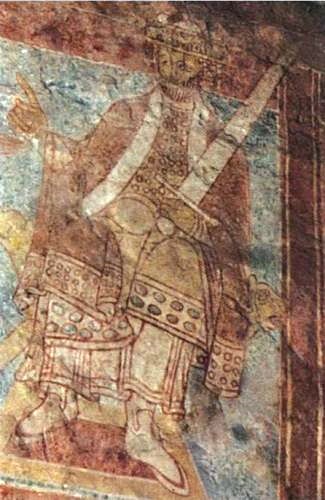
Romanesque fresco depicting King Herod on the judge's seat in Vellev Church between Randers and Silkeborg. Photo kalkmalerier.dk.
In 1257, the fourth day of Easter, Christoffer was ready to strike. He appeared at Scania County Ting and took the judge's seat together with Bishop Niels of Viborg. Here he urged all who had complaints about the archbishop to step forward. There were many who had complaints. As the king had predicted, Jacob Erlandsen then declared that he could not be judged by a secular court but only by the pope in Rome.
But by declaring himself above the ordinary crowd, the archbishop incurred the enmity and unwillingness of the Scanians, for they themselves had worked to limit the king's power at the meetings in Nyborg, and now they got proof from the archbishop with his own mouths and in the presence of witnesses for that he wished to become an even more untoachable, elevated, and exclusive monarch for them than the kings had ever been.
Then the king declared that when Jacob Erlandsen himself would not abide by the old laws of the church, the peasants did not have to do so either, and therefore they no longer had to pay tithes to the archbishop. In doing so, he undoubtedly won many followers.
After Erlandsen had thus become politically isolated from the Scanians, the king was able to go a step further. One week later he issued a declaration that all the privileges of the archdiocese had been abolished and he demanded that all his sworn nobles instead entered into his own service. If they did not do this, they would be considered ordinary taxable peasants.
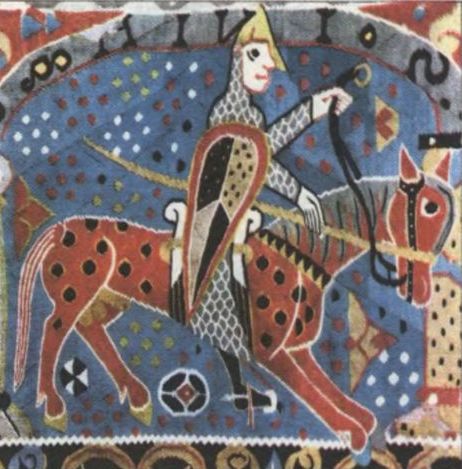
Tapestry from Baldishol Stave Church in Norway, dated to the 1100's. It now hangs at the Museum of Industrial Art in Oslo. Photo Flemming Rickfors.
But later this summer, black clouds drew together over the king again. King Håkon of Norway sailed down through the sound with a fleet of over 300 ships. Ryd Monastery Chronicle writes for the year 1257: "King Håkon of Norway was in Denmark."
However, presumably to the great annoyance of the archbishop, he contented himself with issuing an ultimatum to King Christoffer: Did he want war or peace?
Christoffer grabbed the outstretched hand without hesitation and reconciled in every way with the King of Norway and they became close friends. Christoffer called Håkon his "father" and he gave his "son" a magnificent longship called "Mariasuden" with golden dragon heads and pictures on the sail.
One may wonder that King Håkon went to Denmark with a large fleet. But subsequent events can provide an explanation.
It is very likely that Jacob Erlandsen sent letters and messengers - not only to Norway - but to all kings and princes in the neighboring kingdoms - with alarming messages that God's enemies had taken power in Denmark led by the wicked king and with a call to them all immediately to take up the cross and come to the rescue of the needy Christianity in Denmark.
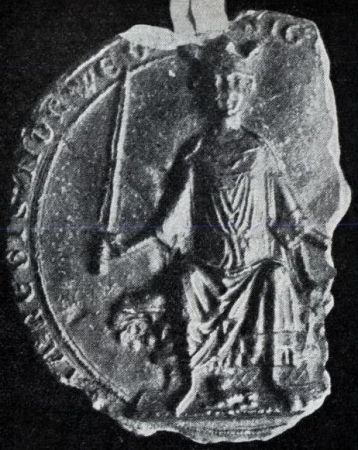
Håkon 4. Håkonson's seal. King Håkon 4. of Norway ended more than 100 years of Norwegian civil war between the Birkebeiners and the Baglers by marrying the Bagler King's daughter and defeating the remaining small rebel groups. He ruled Norway for 47 years. He died on the Orkney Islands when he defended the islands against attacks from the King of Scotland. Photo "Det norske folks liv og historie gjennem tidene fra omkring 1000 til 1280" af Edward Bull Wikimedia Commons.
At least that was what in later events motivated Jaromar of the Rügen, the Brandenburger Mark Counts and probably also the Holstenians, who, however, also had their own more selfish motives.
But when the King of Norway became aware of the real context of the affairs, he seized without hesitation the opportunity to avoid a war in the service of a bad cause, thereby sparing the lives of his ships and his warriors. It is also very likely that he could foresee similar problems with the Norwegian Church, as it was an international problem.
The Holsten counts probably also received such messages from the archbishop with a call to crack down on the enemies of Christianity, who in the archbishop's hysterical universe had taken power in Denmark led by the unbelieving king who did not respect God's representatives on Earth.
At the same time, a small peasant uprising broke out on Sjælland, perhaps and probably inspired by the bishop of Roskilde, Peder Skjalmsen Bang, who was of the Hvide family and Jacob Erlandsen's nephew and faithful supporter. According to the historian Palle Lauring, the revolt was crushed by King Christoffer in a battle at Lejrebro.
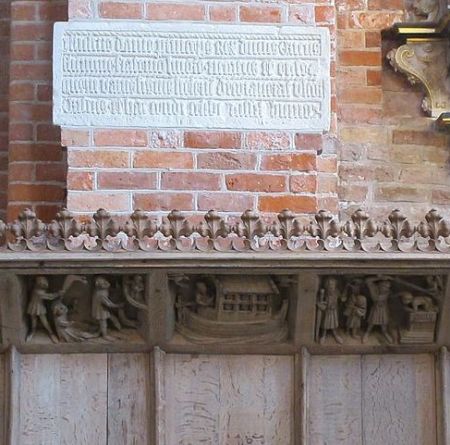
The column grave in Sankt Bendts Kirke in Ringsted, the current and most recent burial site for Erik Ploughpenning. Photo Oleryhlolsson Wikipedia.
In Slesvig, Christoffer defeated the Holsten counts and took possession of the city of Slesvig, and here in 1258 he had the body of his brother, Erik Plovpennings, taken up from the grave in Slesvig Cathedral and taken to Ringsted. Ryd Monastery Chronicle writes for the year 1258: "Christoffer - King Erik's brother - had the aforementioned King Erik taken up from St. Peder's church and taken away, while Bishop Niels was not present"
King Christoffer was an intelligent and energetic man. He had made the plan to make his brother a saint because of his tragic death at the hands of evil men. This would strengthen the royal family and not least discredit the Abel family, which was to blame for his death, and thus make it possible for the royal family to regain Slesvig as a natural part of the Danish kingdom.
Christoffer and Margrete's son, Erik - who was to be bynamed Klipping - had now turned 10 years old and was already hailed as his father's co-king by the kingdom's great men. King Christoffer wanted him to be crowned as his co-king at a solemn ceremony, as the Valdemars had had as a custom since Valdemar the Great.
When he addressed a direct request to Archbishop Jacob Erlandsen to do this, he not only refused to perform the act, but he also forbade everyone else to do. Christoffer's views are reflected in the list of 21 complaints about Jacob Erlandsen, which Danish envoys brought to the Vatican in 1260, which states: "3. Although he had paid homage to the lord King Erik, son of the late King Kristoffer, and swored to serve him faithfully, he has set himself against him and refused to crown him when he was asked to do so, though he had appointed a day for this; yes, he has stepped in the way of his coronation and has banned those who crowned him, even after the appeal was delivered".
But Jacob Erlandsen had stretched the bow too high. This became Christoffer too much. He perceived the archbishop's reluctance as a support for the Abel family's claim to the throne and he struck hard.
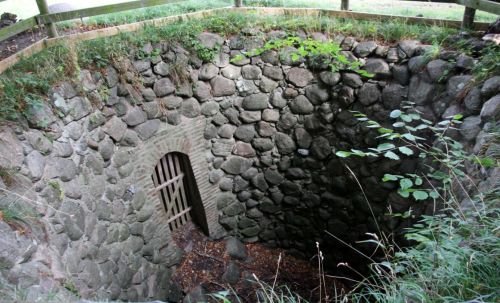
The dungeon in Hagenskov Castle Hill 5 km southeast of Assens is the only surviving of the original medieval castle that burned in the year 1741. The castle is in 1251 mentioned as a crown estate. In 1396, Queen Margrethe 1. repurchased Hagenskov from the Holstein counts, and Hagenskov was then a royal subject for almost 300 years. The original Hagenskov was a four-winged medieval castle in 2 storeys, and it was considered one of the strongest castles in the country. Photo 1001 fortællinger om Danmark.
A cold winter night on 5 February 1259, the archbishop was surprised by Mecklenburger warriors - led by his own brother, Niels Erlandsen - on his estate Gisleberg north of Lund. They dressed him in a secular costume, chained his legs together, gave him a hat with fox tails on his head and led him to custody at the castle Hagenskov south of Assens on Fyn.
As soon as the archbishop's imprisonment became known, the priests of Lund bishop's seat closed the all services in yhe churches of Scania. The archbishop's nephew and bishop of Roskilde, Peder Skjalmsen Bang - also of the Hvide family - reacted in March 1259 by announcing interdict over Roskilde diocese. However, only after he had brought himself to safety on Rügen, which belonged to Roskilde diocese.
But in the other dioceses the services continued as usual and the bishops of Jutland made no secret of their support for the king.
As early as 19 April 1259 - it is said - Jaromar of Rügen, Erik Abelsen, Bishop Peder Skjalmsen Bang and most likely forces of the Brandenburger Mark counts landed on Sjælland quite near Copenhagen with an army consisting mainly of mercenaries from Rügen, the Brandenburger Mark counts and probably also from Holsten. Erik Abelsen was Jaromar's son-in-law.
Copenhagen actually belonged to Roskilde Bishop Seat, after Erik Ploughpenning had briefly had it in his possession - but apparently the bishop was not very popular because the citizens slammed the gate and denied the army access to the city.
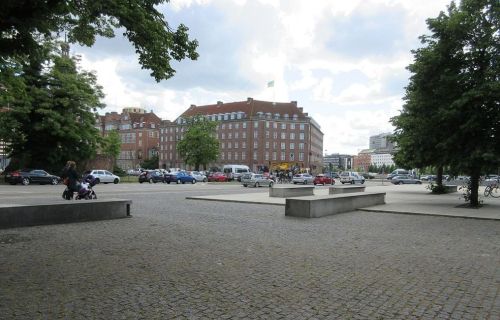
Jaromar's and Erik Abelsen's crusader army broke through Copenhagen's fortifications at the place that is today called Jarmers Square. Photo Ramblersen Wikipedia.
Jaromar attacked immediately and broke through Copenhagen's defenses at the place known today as Jarmers Plads, where Jarmers Tower was later built.
Then Jaromar and Erik Abelsen turned against the rest of Sjælland.
Meanwhile, the king - some historians say his formidable queen - had assembled an army consisting of Sjælland peasants and nobles. The peasant army was Jaromar's army numerically far superior, but most of the peasants were without military training and combat experience.
The armies met at Næstved perhaps in May-June 1259 and it was a crushing victory for Prince Jaromar, Erik Abelsen and their experienced professionals. Ryd Monastery Chronicle for 1259 writes: "and Jarmer af Rygen destroyed much of Sjælland." Older Sjælland Chronicle writes: "There was a battle at Næstved between the peasants and Jarmer."
Various authors state that between 1,800-10,000 men fell in the peasants' army. The dead on the Danish side were buried at the order of the Bishop of Roskilde, Peder Bang, without Christian ceremonies - because they were heretics who had fought against the church.
Jaromar died in Scania the following year. It is said that he visited a woman whom he had fallen in love with or simply desired, yet his feelings were not reciprocated and this woman had hidden a small but very sharp knife in the bed, with which she separated Jaromar from his life.
In 1149, King Svend Grathe, donated the village of Aakirkeby and three of the four Bornholm herreds to Archbishop Eskild in Lund, namely Haslæ Herred, Hænnings Herred and Michlingæ Herred. Only Rothne Herred, which is Rønne, the king retained together with the royal castle in Almindingen. Bornholm became thus divided between king and church.
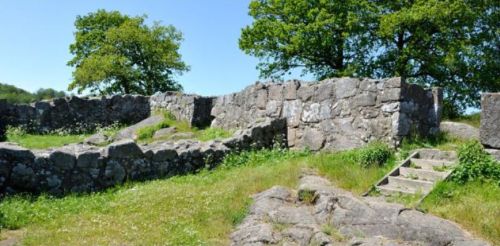
The ruins of Lilleborg on Bornholm. The castle is located in the middle of Bornholm between Rønne and Svaneke. Foto Bornholm Secrets.
Prince Jaromar of Rügen had already in 1257 rebelled against his lord King Christoffer 1. it is said. He conquered the royal fortress on Bornholm, Lilleborg, together with Anders Erlandsen, a brother of Archbishop Jakob Erlandsen, and chopped down the entire crew. In the list of complaints about Jacob Erlandsen, which the Danish envoys brought to the Vatican in 1260, it says: "2. Jærmer and the archbishop's brother Anders, together with the same archbishop's men, have killed about 200 of the king's men on the island of Bornholm, taxed the others hard and dismantled the king's fortresses there on the island; and he has confessed that these things were done at his command."
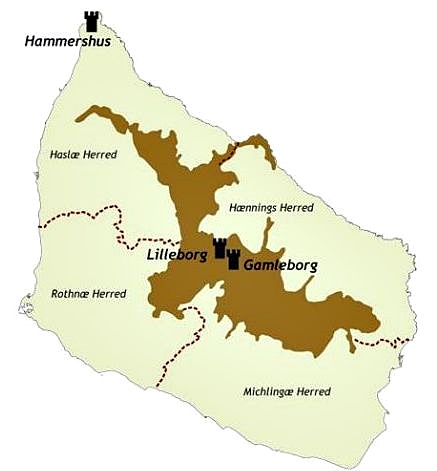
In the Middle Ages, Bornholm was divided into four herreds, namely Rothne Herred, Haslæ Herred, Hænnings Herred and Michlingæ Herred. The king ruled over Rothne Herred and the archbishop over the other three. The castle in the middle of the island, today called Lilleborg, was the king's property in Christoffer's time. Gamleborg, which is nearby, can be traced back to the time 900-1100. Photo Naturstyrelsen.
The exact date of the conquest is not known, but it may have been before Jacob Erlandsen's imprisonment. Jaromar fell for a woman's hand in Scania in 1260. We must believe that from the attack on Copenhagen in April 1259 until his death in 1260 he has been busy leading his probably rather large army on Sjælland and in Scania, which does not leave him that much time to conquer Lilleborg, as a siege of the castle must have involved prior shipping and then it must hve lasted some time. Therefore, we can believe that it is most likely that he conquered Lilleborg before Jacob Erlandsen's imprisonment in February 1259, but probably after Christoffer's legal attack on the archbishop of Skåne County Council in March 1257, that the archbishop's supporters also must have considered an intolerable provocation.
As former kings were followed by the hird, a medieval king was followed by a corps of young men, often younger sons of less wealthy nobles, who served "both for gold and honor," as the folk songs say.
In the circle around the king were also found foreign knights, including Count Albrekt of Braunschweig and, marvelous, Count Gunzelin of Schwerin, whom Christoffer might have met in his childhood during his captivity at the castle of Schwerin. Like other foreign corps in history, they were completely reliable and loyal - as long as they were paid.
In 1251 Count Niels of Halland died, leaving a minor son. Christoffer managed to avoid a renewal of the duchy. But everything costs, and he had to give the counts Gunzelin of Schwerin and Albrekt of Braunschweig the islands of Samsø and Endelave.
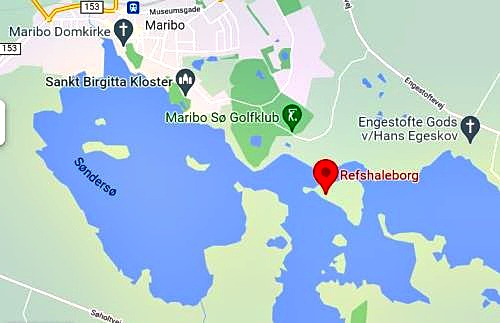
Refshaleborg on the island Borgø in the lake Søndersø 2,5 km from Maribo. Photo Google Maps.
In 1256, a peasant uprising broke out in Denmark. Ryd Monastery Chronicle writes: "All the kåd-men were furious with their clubs". "The kåd-men" was the poorest rural population, who lived in "kåd", which were cottages. They used clubs because they were so poor that they could not afford weapons. But apparently they used their clubs effectively, the historian Erik Kjersgaard says that they conquered the royal fortress Revshaleborg at Maribo. Nothing further has been told about the insurgency, so it is likely that it was beaten down with a heavy hand.
As mentioned above, in 1248 Christoffer married the renowned Margrethe Sambiria, daughter of Duke Sambor 2. of Pomerellen, which was a modest duchy in eastern Pomerania. Her mother's name was Mechtilde and she was from Mecklenburg.
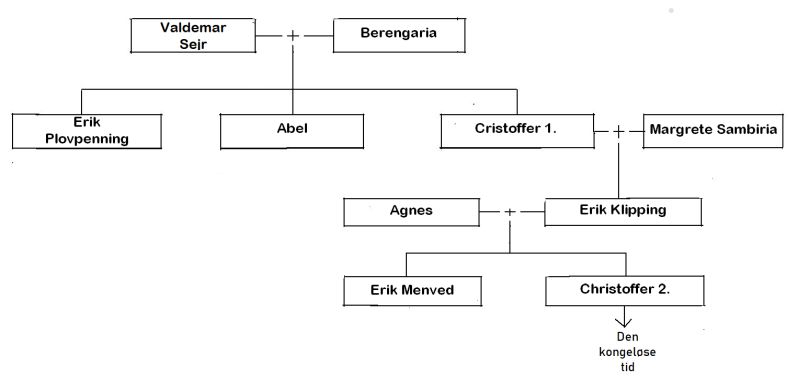
Simplyfied family tree for the Valdemars from Valdemar the Victorious to Christoffer 2.
Erik Ploughpenning, Abel and Christoffer 1. were sons of Valdemar the Victorious and Berengaria and they all became kings, one after the other. Erik Klipping, who suffered death in Finnerup Lade, was the son of Christoffer 1. and the famous Margrete Sambiria. His sons with Agnes of Brandenburg were Erik Menved and Christoffer 2, who both became kings. Of these seven kings, only three died a natural death.
After Christoffer's sudden death in Ribe, she took over the government of Denmark with great energy and determination as a guardian for her 11-year-old son, Erik - who was to be bynamed Klipping. Margrethe was later nicknamed Sprænghest, allegedly because she should have ridden a horse to death during the battle of Lohede, but also in recognition of her unfeminine, consistent and determined leadership style. The folk songs called her Black Grethe because of her black hair.
From Christoffer's death until 1266, she fought like a lioness for her little son against Denmark's numerous enemies - who were especially Archbishop Jakob Erlandsen, the Abel lineage and the Holstenians.
Danish Biographical Lexicon mentions that her marriage to Christoffer was extremely happy and she gave birth to his son Erik and daughter Mechtilde, who was named after Margrethe's mother. Mechtilde married Mark Count Albrecht of Brandenburg.
But Margrete and Christoffer had another son, as Pope Urban IV could accuse Peder Bang of having banned a Junker Valdemar together with the young Erik Klipping. This Valdemar is also mentioned in the so-called Ringsted board of funerals in Ringsted Cathedral. The board indicates his death date as December 21 but not his year of death.
But it tells that this Valdemar got his grave at the foot of Duke Knud Valdemarsen's grave, so he must have died after this uncle died on 1 Oct. 1260, but apparently before Margrete in 1263 sent letter to the pope requesting his acceptance of female succession, stating that the king has no brothers.
In addition, another daughter is mentioned, as Erik Klipping in his letters of privilege to Kiel and Hamburg on 20 July 1283 mentions Count Johan 2. of Holstein as his brother-in-law and his wife as his sister. Other sources indicate that her name was Margrete.
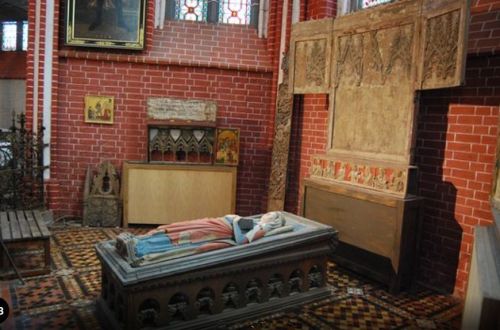
Margrethe Sambiria's tomb in beautiful surroundings in Bad Doberan. It is difficult not to think that the beauty of this tomb is in contrast to all the other Danish and Norwegian medieval kings - and queens - who are allegedly buried in this and that church, but the tomb can not be further located. Photo Tripadvisor.
When her son Erik came of age in 1265, Margrethe was handed over the rule of Estonia with the title "Lady to Estonia". Among other things, she initiated the construction of Tallinn's city wall.
Margrethe Sambiria died 1282 or 1283 in Rostock in Mecklenburg. She is buried in the burial church of the Mecklenburg princely family, the abbey church of Bad Doberan. One may wonder what were the reasons why a Danish queen was thus buried abroad.
She was spared to experience her son's death at the hands of murderers in Finnerup Lade a few years later.
King Kristoffer 1. died suddenly in Ribe on May 29 or June 3 1259 about 40 years old.
There is no intelligence of prior illness, on the contrary. The king was apparently healthy and well, being able to travel around in his kingdom. A source says that King Kristoffer stayed at Taarnborg on April 15 1259, which must have been the crossing location over the Great Belt towards Nyborg, which has later been replaced by Korsør. Here he issued a letter in which he urges deans and parish priests in Halland to, for the sake of the people, open their churches, despite the country's interdict.
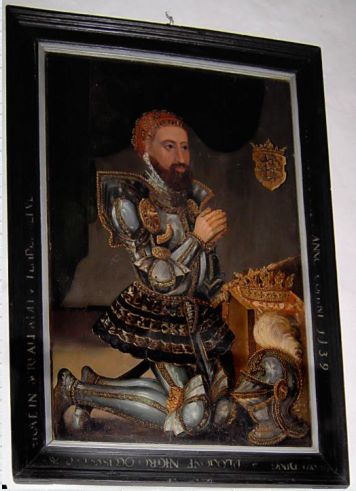
Painting from the 1500's of Christoffer 1. in Ribe Cathedral. There is with great certainty no portrait likeness. There is no description of what he looked like. Here he is made a little dark - probably because his mother was from Portugal. Photo Treenighedskirken i Grådybet i Esbjerg.
His closest men and the queen, who was present in Ribe when he died, are in no doubt that he was poisoned and that Jacob Erlandsen was behind. Given the fanaticism and ruthlessness with which Jacob Erlandsen and his followers fought their holy war, it sounds completely possible.
Most historians believe that it was only a rumor that Christoffer was poisoned - it was really not that bad, he died most likely of natural causes. But what do we know about this? Why do we think that we - 750 years later - know better than the Queen and King's men who were at the location when it happened?
Perhaps after some time, the queen and her advisers came to the conviction that the perpetrator was Abbot Arnfast from Ryd Monastery, who was present in Ribe at the very moment of the murder. He should have put poison in the altar wine, when he offered the king the holy communion.
Ryd Monastery is located about 80 km from Ribe at the other end of Southern Jutland about 10 km northeast of Flensburg.
Only five years after Christoffer's death, Pope Urban 4. himself confirmed in a letter to Jacob Erlandsen that Arnfast was Christoffer's enemy and the general opinion was that he killed Christoffer with poison: " - to the other, the one in Aarhus, you actually consecrated what was indeed a curse, Arnfast, King Erik's obvious enemy, since it is said that he must have put to death this king's father by poison, and you did this before the question of our venerable brother Tyge's election as bishop of Aarhus was decided at this seat."
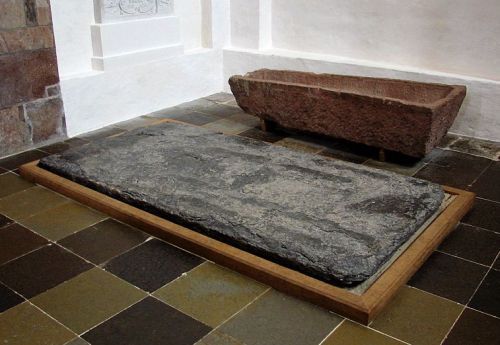
Christoffer 1’s tombstone in Ribe Cathedral was found during an excavation in front of the altar in 1987. The heavily eroded stone is made of black Belgian marble and was originally adorned with a relief of the king made of alabaster and brass. Behind it is his sandstone sarcophagus, which was also found in 1987. It contained the remains of at least two people. Foto Wikiwand.
A passage in Øm Monastery Chronicle - written only 10 years after Christoffer's death - gives us information that Jacob Erlandsen appointed Abbot Arnfast as bishop of Aarhus after Christoffer's death, one can believe as a reward for his efforts, but Arnfast did not dare to accept the appointment for fear of the queen.
Bishop Tyge of Aarhus sued the monks in Øm Kloster for Åbo Sysselting for expelling him from the monastery and also for hiding the king's enemies, including Abbot Arnfast. Øm Kloster Chronicle writes about this: "And since this is now being talked about, I have to tell you something about him. At the time when the episcopal see in Aarhus was vacant, there were twelve monks with right to vote. When they made the choice, the six voted for one, and the other six for another; this resulted in a long-running dispute between them, so that the choice fell to Archbishop Jakob, who himself had been driven out of the kingdom due to the feud that was going on between him and King Kristoffer." - "The said archbishop then chose the excellent and well-educated man of noble birth, Mr. abbot of Ryd monastery named Arnfast, and consecrated him bishop of Aarhus. This Arnfast, however, did not dare, because he had been chosen and consecrated against the will of the Queen, to clothe himself in the goods of the said church, but returned to his aforesaid abbey, where he resided right up to the day of his death." - "But this good man has never been in this house since he was ordained a bishop."
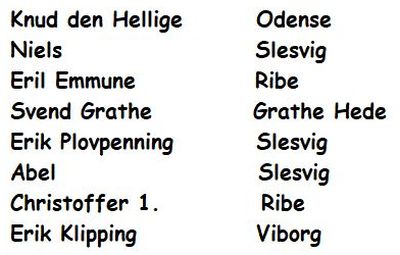
Danish medieval kings who suffered an unnatural death, and their graves. There was a custom in Denmark that kings who fell in battle or otherwise suffered an unnatural death were mainly buried where they fell. Knud the Holy was buried in Odense, where he fell. Niels was buried in Slesvig, where he fell. Erik Emmune was buried in Ribe not far from Urnehoved Ting, where he was killed. Svend Grathe was buried on the battlefield where he fell. Erik Plooughpenning was originally laid to rest in Slesvig, where he was killed. Abel was buried in his hometown, Slesvig, not far from Husum. Erik Klipping was killed by many stab wounds in Finnerup Lade near Viborg - and buried in Viborg. Christoffer 1. found his death in Ribe and was buried in Ribe and therefore one must assume that his contemporaries really were convinced that he there died an unnatural death - by poison in the altar wine given by Abbot Arnfast from Ryd Monastery - and they were and are after all, the closest witnesses - and the only ones -and must know best.
The priests and bishop of Ribe cathedral defied the interdict and buried their king in front of the altar in the cathedral with all ceremonies and honors. But It happened to his grave as it has happened to so many other medieval kings' tombs in Denmark and Norway. It was ignored and forgotten and was first found during an excavation in front of the altar in 1987.
|
Anklager mod ærkebisp Jakob Erlandsen Danmarkshistorien Slaget ved Næstved LinkFang Slaget ved Næstved 1259 Palle Birk Hansen Anders Andersen af Veksø.pdf Steen Johansen Blev Kong Kristoffer dræbt af biskoppen i Ribe? DLP Nyt Jakob Erlandsen Danmarkshistorien Jacob Erlandsen AB Information Christoffer 1. Netleksikon Granit i Angel - Jane Bossen Grænseforeningen Bidrag til belysning af Valdemarssönnernes tidsalder Hans Olrik Ryd Klosters Krønike Heimskringla Kalkmalerier.dk Kalkmalerier.dk Tronskiftet 1250 og dets følger Danmarkshistorien Lex.dk Margrete Sambiria Dansk Biografisk Leksikon Projekt Runeberg Jakob Erlandsen Dansk Biografisk Leksikon Danmarks Historie "Valdemars Sønner og Unionen" af Palle Lauring - Det Schønbergske Forlag 1967. Danmarks Historie Bind 4 "Borgerkrig og Kalmarunion" af Erik Kjersgaard Politikkens Forlag 1963. |
| Til start |